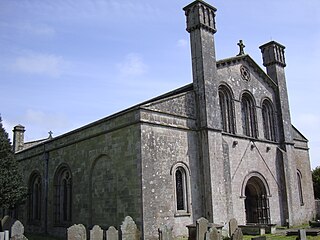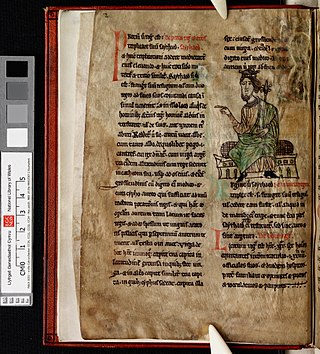
Hywel ap Cadell, commonly known as Hywel Dda, which translates to Howel the Good in English, was a Welsh king who ruled the southern Welsh kingdom of Deheubarth and eventually came to rule most of Wales. He became the sole king of Seisyllwg in 920 and shortly thereafter established Deheubarth, and proceeded to gain control over the entire country from Prestatyn to Pembroke. As a descendant of Rhodri Mawr through his father Cadell, Hywel was a member of the Dinefwr branch of the dynasty. He was recorded as King of the Britons in the Annales Cambriæ and the Annals of Ulster.

The Red Book of Hergest, Oxford, Jesus College, MS 111, is a large vellum manuscript written shortly after 1382, which ranks as one of the most important medieval manuscripts written in the Welsh language. It preserves a collection of Welsh prose and poetry, notably the tales of the Mabinogion and Gogynfeirdd poetry. The manuscript derives its name from the colour of its leather binding and from its association with Hergest Court between the late 15th and early 17th century.

The National Library of Wales, in Aberystwyth, is the national legal deposit library of Wales and is one of the Welsh Government sponsored bodies. It is the biggest library in Wales, holding over 6.5 million books and periodicals, and the largest collections of archives, portraits, maps, and photographic images in Wales. The Library is also home to the national collection of Welsh manuscripts, the National Screen and Sound Archive of Wales, and the most comprehensive collection of paintings and topographical prints in Wales. As the primary research library and archive in Wales and one of the largest research libraries in the United Kingdom, the National Library is a member of Research Libraries UK (RLUK) and the Consortium of European Research Libraries (CERL).

The Black Book of Carmarthen is thought to be the earliest surviving manuscript written solely in Welsh. The book dates from the mid-13th century; its name comes from its association with the Priory of St. John the Evangelist and Teulyddog at Carmarthen, and is referred to as black due to the colour of its binding. It is currently part of the collection of the National Library of Wales, where it is catalogued as NLW Peniarth MS 1.

Cyfraith Hywel, also known as Welsh law, was the system of law practised in medieval Wales before its final conquest by England. Subsequently, the Welsh law's criminal codes were superseded by the Statute of Rhuddlan in AD 1284 and its civil codes by Henry VIII's series of Laws in Wales Acts between 1535 and 1542.

Brogyntyn, or Porkington, is a mansion in the parish of Selatyn to the north-west of Oswestry in Shropshire, England. Brogyntyn Hall was the home of the Ormsby-Gore family from 1815, and had previously been the estate of their ancestors the Maurices and Owens since the sixteenth century. It was abandoned and uninhabited from around 1985.

Brut y Brenhinedd is a collection of variant Middle Welsh versions of Geoffrey of Monmouth's Latin Historia Regum Britanniae. About 60 versions survive, with the earliest dating to the mid-13th century. Adaptations of Geoffrey's Historia were extremely popular throughout Western Europe during the Middle Ages, but the Brut proved especially influential in medieval Wales, where it was largely regarded as an accurate account of the early history of the Celtic Britons.

The White Book of Hergest was an important Welsh manuscript compiled in c. 1450. It contained many Welsh poems and prose texts and was a significant source for several antiquaries of the 17th and 18th centuries, but disappeared in the early 19th century, probably being destroyed in a fire in a London bookbinder's shop in around 1810.

The Peniarth Manuscripts, also known as the Hengwrt–Peniarth Manuscripts, are a collection of medieval Welsh manuscripts now held by the National Library of Wales in Aberystwyth. The collection was originally assembled by Robert Vaughan of Hengwrt, Merionethshire. During the 19th century it was held in Peniarth Mansion, Llanegryn.
Wales has produced a number of manuscripts over the centuries. Although most were written in Middle Welsh or Old Welsh, some were also written in Latin. In some of the more recent manuscripts it is not uncommon to have texts in Welsh, Latin, French and English in the same volume. However, some of the most important medieval manuscripts were written in Latin only, e.g. the Cyfraith Hywel.
The General Manuscript Collection of the National Library of Wales includes three series of manuscripts: NLW Manuscript series; NLW ex series of Manuscripts; and, NLW Rolls. All manuscripts acquired by the library through either donation or purchase are added to this open-ended series, either singly or in groups, if they are: a) in a format compatible with the collection, i.e. manuscript books or rolls, or unbound material that can be filed; and, b) not integral to an archive or individual collection. There is, however, much archival material, mostly correspondence, held in the General Manuscripts Collection. The holdings in the General Manuscript Collection are catalogued in the Handlist of manuscripts in the National Library of Wales, which focuses on those manuscripts in the National Library which are not part of the foundation collections; there were over fifteen thousand when the first volume of the handlist appeared in 1940, and the collection had increased to 23,233 by 31 March 1994.
Peniarth Manuscript 259B, known as Pomffred since it had previously been owned by the constable of Pontefract Castle, is a version of the Laws of Hywel Dda. Aneurin Owen assigned this manuscript the siglum Z in his Ancient laws and institutes of Wales. It is one of the Peniarth Manuscripts in the National Library of Wales. It was transcribed in the mid-sixteenth century by two hands: Richard Longford and his amanuensis, from an earlier exemplar owned by Einion ab Addain, who was serving a prison sentence in Pontefract at the time that it was copied.
The Boston Manuscript of the Laws of Hywel Dda is a Welsh manuscript created in south-west Wales c.1350-1400 and added to by other scribes in the later Middle Ages. The complex composition of the manuscript has been mapped by archivists at the National library Wales. It is 99 vellum leaves and 98mm by 50mm and is not illuminated, although it does use some coloured inks. It was acquired at auction at Sotherby's by the National Library of Wales in 2012 for £541,250 and is now part of the General Manuscript Collection.
Daniel Huws FLSW is the world's leading authority of the last hundred years on Welsh manuscripts, with contributions that are held to represent a significant advance on those of John Gwenogvryn Evans.

Peniarth 28 is the earliest of the surviving copy of the Laws of Hywel Dda. The manuscript, which is written in Latin, dates from the second half of the thirteenth century. It is part of the Peniarth Manuscript Collection that was the foundation collection of the National Library of Wales.

The Llanbeblig Book of Hours is an illuminated manuscript in the National Library of Wales that dates from the close of the fourteenth century. Entries in the Calendar link the Llanbeblig Hours to Wales, and more specifically the dedication of the church of Saint Peblig, which is marked June 6, connects it with Caernarfon.
Esboniadau ar Gyfraith Hywel Dda is a volume of commentaries on the Laws of Hywel Dda from the late fourteenth century that is known as 'siglum H'. The manuscript contains almost 500 triads and some unique material, but a large part of it is illegible because of the oak apples stains conferred on it by John Jones, Gellilyfdy.

The History of the Kings, or Brut y Brenhinedd, is a Welsh translation of Geoffrey of Monmouth’s Historia Regum Britanniae. The manuscript, which was copied in the late fifteenth century, is probably the only illustrated Welsh-language medieval narrative. It is part of the Peniarth Manuscripts collection at the National Library of Wales.














